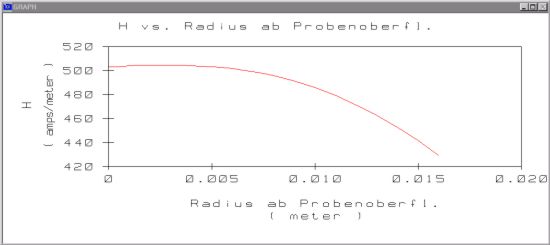Analysis of the fields H and B in soft-magnetic solid samples
The behavior and the characteristics of magnetic cores among other things are determined through
- the magnetization characteristic B(H)
- the B(H)-loop
of the assigned materials.
If one excludes ringcore measurements, these characteristic functions in general at samples in a yoke are examined. In the transition zones from the pole to the sample are formed source/sinking of the field strength. They entail inhomogeneous field processes H(r, z) and/or B(r, z) in the axial and radial direction. In particular with compact samples with a relationship
(length diameter)sample = (L/D)sample < 10
one has to expect in general with inhomogeneous fields H(r, z) and/or B(r, z) over the entire length z of the sample. In the following illustration an example is represented (FEM computation without air gap,
¼ surface & ½ height of the sample).


Possibilities of influence the field inhomogeneities in the transition zones from the pole to the sample and in the sample are to vary
- the geometrical dimensions of the sample (length, cross section)
- the relationship Asample / Apole of the cross sections of the poles and the sample
- the relationship µ(B)Probe / µ(B)Pol of the permeability
- the arrangement and type of the field coils
By the use of several HALL sensors it is possible additionally
- the quantity H(r,z) of the tangential field strength to determine
- the curve H(r, z) to formulate mathematically.
The determination of the magnetic characteristics of a soft-magnetic material at samples with an unfavourable relationship (length/diameter) is problematic. It was tried, the inhomogenous field processes to determine by several locally separated arranged sensors.